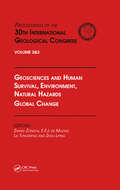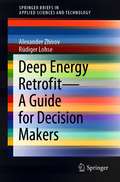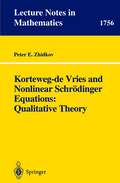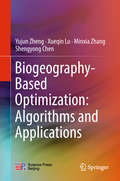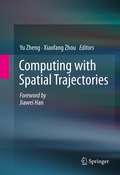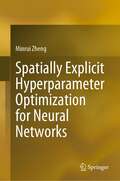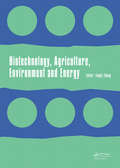- Table View
- List View
Proceedings of GeoShanghai 2018 International Conference: Fundamentals of Soil Behaviours
by Annan Zhou Junliang Tao Xiaoqiang Gu Liangbo HuThis book is the second volume of the proceedings of the 4th GeoShanghai International Conference that was held on May 27 - 30, 2018. The book, entitled “Fundamentals of Soil Behaviours”, presents the recent advances and technology in the understanding and modelling of fundamentals of soil’s behaviours. The subject of this book covers a wide range of topics related to soil behaviours in geotechnical engineering, geoenvironmental engineering and transportation engineering. The state-of-the-art theories, methodologies and findings in the related topics are included. This book may benefit researchers and scientists from the academic fields of soil and rock mechanics, geotechnical engineering, geoenvironmental engineering, transportation engineering, geology, mining and energy, as well as practical engineers from industry.Each of the papers included in this book received at least two positive peer reviews. The editors would like to express their sincerest appreciation to all of the anonymous reviewers all over the world, for their diligent work.
Geosciences and Human Survival, Environment, Natural Hazards, Global Change: Proceedings of the 30th International Geological Congress, Volume 2 & 3
by Zhang Zhonghu E.F.J. De Mulder Liu Tungsheng Zhou LipingThe proceedings of the 30th International Geological Congress held in Beijing, China in August 1997. These two volumes focuses on geosciences and human survival, environment, natural hazards and global changes. They aim to present a view of contemporary geology.
Non-Fourier Heat Conduction: From Phase-Lag Models to Relativistic and Quantum Transport
by Alexander I. ZhmakinThis book presents a broad and well-structured overview of various non-Fourier heat conduction models. The classical Fourier heat conduction model is valid for most macroscopic problems. However, it fails when the wave nature of the heat propagation becomes dominant and memory or non-local spatial effects become significant; e.g., during ultrafast heating, heat transfer at the nanoscale, in granular and porous materials, at extremely high values of the heat flux, or in heat transfer in biological tissues. The book looks at numerous non-Fourier heat conduction models that incorporate time non-locality for materials with memory, such as hereditary materials, including fractional hereditary materials, and/or spatial non-locality, i.e. materials with a non-homogeneous inner structure. Beginning with an introduction to classical transport theory, including phase-lag, phonon, and thermomass models, the book then looks at various aspects of relativistic and quantum transport, including approaches based on the Landauer formalism as well as the Green-Kubo theory of linear response. Featuring an appendix that provides an introduction to methods in fractional calculus, this book is a valuable resource for any researcher interested in theoretical and numerical aspects of complex, non-trivial heat conduction problems.
Deep Energy Retrofit: A Guide to Achieving Significant Energy Use Reduction with Major Renovation Projects (Springerbriefs In Applied Sciences And Technology Ser.)
by Alexander Zhivov Rüdiger LohseThis book provides detailed information on how to set up Deep Energy Retrofits (DERs) in public buildings, and shares in-depth insights into the current status of the major technologies, strategies and best practice examples of how to cost-effectively combine them. Case studies from the U.S.A. and Europe show that that Deep Energy Retrofit can be achieved with a limited core technologies bundle readily available on the market. Characteristics of some of these core technology measures depend on the technologies available on an individual nation’s market, on the minimum requirements of national standards, and on economics (as determined by a life cycle cost analysis). Also, requirements to building envelope-related technologies (e.g., insulation levels, windows, vapor and water barriers, and requirements for building airtightness) depend on specific climate conditions. This Guide provides best practice examples of how to apply these technologies in different construction situations.High levels of energy use reduction using core technology bundles along with improvements in indoor climate and thermal comfort can be only achieved when a Deep Energy Retrofit adopts a quality assurance process. In addition to design, construction, commissioning, and post-occupancy phases of the quality assurance process, the Guide emphasizes the importance of clearly and concisely formulating and documenting the Owner’s goals, expectations, and requirements for the renovated building during development of the statement of work. Another important component of the quality assurance process is a procurement phase, during which bidders’ qualifications, their understanding of the scope of work and its requirements, and their previous experience are analyzed.The building sector holds the potential for tremendous improvements in terms of energy efficiency and reducing carbon emissions, and energy retrofits to the existing building stock represent a significant opportunity in the transition to a low-carbon future. Moreover, investing in highly efficient building materials and systems can replace long-term energy imports, contribute to cost cutting, and create a wealth of new jobs. Yet, while the technologies needed in order to improve energy efficiency are readily available, significant progress has not yet been made, and “best practices” for implementing building technologies and renewable energy sources are still relegated to small “niche” applications.Offering essential information on Deep Energy Retrofits, the book offers a valuable asset for architects, public authorities, project developers, and engineers alike.
Deep Energy Retrofit—A Guide for Decision Makers (SpringerBriefs in Applied Sciences and Technology)
by Alexander Zhivov Rüdiger LohseMany governments worldwide are setting more stringent targets for reductions in energy use in government/public buildings. Buildings constructed more than 10 years ago account for a major share of energy used by the building stock. However, the funding and “know-how” (applied knowledge) available for owner-directed energy retrofit projects has not kept pace with new requirements. With typical retrofit projects, reduction of energy use varies between 10 and 20%, while actual executed renovation projects show that energy use reduction can exceed 50%, and can cost-effectively achieve the Passive House standard or even approach net zero-energy status (EBC Annex 61 2017a, Hermelink and Müller 2010; NBI 2014; RICS 2013; Shonder and Nasseri 2015; Miller and Higgins 2015; Emmerich et al. 2011).Building energy efficiency (EE) ranks first in approaches with resource efficiency potential with a total resource benefit of approximately $700 billion until 2030. EE is by far the cheapest way to cut CO2 emissions (McKinsey 2011, IPCC 2007). However, according to an IEA study (IEA 2014a), more than 80% of savings potential in building sector remains untapped. Thus, the share of deployed EE in the building sector is lower than in the Industry, Transport, and Energy generation sectors. Estimates for the deep renovation potentials show: €600-900bn investment potential, €1000-1300bn savings potential, 70% energy-saving potential, and 90% CO2 reduction potential.
Energy Master Planning toward Net Zero Energy Resilient Public Communities Guide
by Alexander ZhivovBest practices from around the world have proven that holistic Energy Master Planning can be the key to identifying cost-effective solutions for energy systems that depend on climate zone, density of energy users, and local resources. Energy Master Planning can be applied to various scales of communities, e.g., to a group of buildings, a campus, a city, a region, or even an entire nation.Although the integration of the energy master planning into the community master planning process may be a challenging task, it also provides significant opportunities to support energy efficiency and community resilience by increasing budgets for investments derived from energy savings, by providing more resilient and cost-effective systems, by increasing comfort and quality of life, and by stimulating local production, which boosts local economies.The Guide is designed to provide a valuable information resource for those involved in community planning: energy systems engineers, architects, energy managers, and building operators. Specifically, this Guide was developed to support the application of the Energy Master Planning process through the lens of best practices and lessons learned from case studies from around the globe. The Guide introduces concepts and metrics for energy system resilience methodologies, and discusses business and financial models for Energy Master Plans implementation. This information can help planners to establish objectives and constraints for energy planning and to select and apply available technologies and energy system architectures applicable to their diverse local energy supply and demand situations.This Guide is a result of research conducted under the International Energy Agency (IEA) Energy in Buildings and Communities (EBC) Program Annex 73 and the US Department of Defense Environmental Security Technology Certification Program (ESTCP) project EW18-5281 to support the planning of Low Energy Resilient Public Communities process that is easy to understand and execute.
Water Resources in Central Asia: International Context (The Handbook of Environmental Chemistry #85)
by Sergey S. Zhiltsov Igor S. Zonn Andrey G. Kostianoy Aleksandr V. SemenovThis book outlines the current status of water resources management in Central Asia countries, and provides a review of the history, policies and transboundary cooperation regarding water resources in the region. Particular attention is given to the water-energy-food-environmental nexus, and to the application of the UNECE Environmental Conventions in Central Asia. Readers will also learn about the US and German environmental policies applied in Central Asia, and will discover specific case studies on water resources policies in Kazakhstan, China, Kyrgyzstan, Uzbekistan, Tajikistan, Turkmenistan, and Afghanistan. Together with the companion volumes on Water Bodies and Climate Change in Central Asia and Water Resources Management in Central Asia, it offers a valuable source of information for a broad readership, from students and scientists interested in the environmental sciences, to policymakers and practitioners working in the fields of water resources policy and management, international relations, and environmental issues.
Oil and Gas Pipelines in the Black-Caspian Seas Region (The Handbook of Environmental Chemistry #51)
by Sergey S. Zhiltsov Igor S. Zonn Andrey G. KostianoyThis book concisely describes the architecture of the oil and gas pipelines in the Black-Caspian Seas Region and analyzes the status quo and perspectives of oil and gas production in this region. The authors present numerous projects, each of which has made a substantial contribution to the development of pipeline transport and transit in this part of the world, and discuss them in detail. The topics covered include: the region’s geographic characteristics; the region’s hydrocarbon potential; Russian and EU policy on pipeline transport; Kazakhstan’s pipeline policy; Chinese pipeline projects; the Bulgarian gas transmission system; environmental risks in the production and transportation of hydrocarbons; satellite monitoring; and subsea leak detection. This volume offers a valuable resource for politicians, specialists in the oil and gas business, decision-makers, and environmentalists alike.
Shale Gas: Ecology, Politics, Economy (The Handbook of Environmental Chemistry #52)
by Sergey S. ZhiltsovThis book highlights various aspects of shale gas production and discusses the associated problems, which have greatly influenced the current situation on the global gas market. It focuses on issues such as production technologies, environmental protection, and the impacts of shale gas production on human beings. Further, it investigates the role of shale gas in the development and implementation of foreign policy of many nations that welcomed the possibility to produce this hydrocarbon in their own countries. Taking into consideration the information published by world energy research centers, the prospects of shale gas production in different regions of the world are examined in detail. Given its coverage and scope, the book will greatly benefit specialists in the areas of hydrocarbon production, international relations and foreign policy, world economics and technologies, ecology and environmental protection.
Korteweg-de Vries and Nonlinear Schrödinger Equations: Qualitative Theory (Lecture Notes in Mathematics #1756)
by Peter E. Zhidkov- of nonlinear the of solitons the the last 30 theory partial theory During years - has into solutions of a kind a differential special equations (PDEs) possessing grown and in view the attention of both mathematicians field that attracts physicists large and of the of the problems of its novelty problems. Physical important applications for in the under consideration are mo- to the observed, example, equations leading mathematical discoveries is the Makhankov One of the related V.G. by [60]. graph from this field methods that of certain nonlinear by equations possibility studying inverse these to the problem; equations were analyze quantum scattering developed this method of the inverse called solvable the scattering problem (on subject, are by known nonlinear At the the class of for same time, currently example [89,94]). see, the other there is solvable this method is narrow on hand, PDEs sufficiently and, by of differential The latter called the another qualitative theory equations. approach, the of various in includes on pr- investigations well-posedness approach particular solutions such or lems for these the behavior of as stability blowing-up, equations, these and this of approach dynamical systems generated by equations, etc., properties in wider class of a makes it to an problems (maybe possible investigate essentially more general study).
Unsaturated Soil Mechanics - from Theory to Practice: Proceedings of the 6th Asia Pacific Conference on Unsaturated Soils (Guilin, China, 23-26 October 2015)
by Cheng Zhenghan Changfu Wei De'An Sun Xongfu XuIn the past decades advances have been made in the research and practice on unsaturated soil mechanics. In 2000 the first Asia-Pacific Conferences on Unsaturated Soils was organized in Singapore. Since then, four conferences have been held under the continued support of the Technical Committee on Unsaturated Soils (TC106) of the International Socie
Biogeography-Based Optimization: Algorithms and Applications
by Yujun Zheng Xueqin Lu Minxia Zhang Shengyong ChenThis book introduces readers to the background, general framework, main operators, and other basic characteristics of biogeography-based optimization (BBO), which is an emerging branch of bio-inspired computation. In particular, the book presents the authors’ recent work on improved variants of BBO, hybridization of BBO with other algorithms, and the application of BBO to a variety of domains including transportation, image processing, and neural network learning. The content will help to advance research into and application of not only BBO but also the whole field of bio-inspired computation. The algorithms and applications are organized in a step-by-step manner and clearly described with the help of pseudo-codes and flowcharts. The readers will learn not only the basic concepts of BBO but also how to apply and adapt the algorithms to the engineering optimization problems they actually encounter.
Computing with Spatial Trajectories
by Yu Zheng Xiaofang ZhouSpatial trajectories have been bringing the unprecedented wealth to a variety of research communities. A spatial trajectory records the paths of a variety of moving objects, such as people who log their travel routes with GPS trajectories. The field of moving objects related research has become extremely active within the last few years, especially with all major database and data mining conferences and journals. Computing with Spatial Trajectories introduces the algorithms, technologies, and systems used to process, manage and understand existing spatial trajectories for different applications. This book also presents an overview on both fundamentals and the state-of-the-art research inspired by spatial trajectory data, as well as a special focus on trajectory pattern mining, spatio-temporal data mining and location-based social networks. Each chapter provides readers with a tutorial-style introduction to one important aspect of location trajectory computing, case studies and many valuable references to other relevant research work. Computing with Spatial Trajectories is designed as a reference or secondary text book for advanced-level students and researchers mainly focused on computer science and geography. Professionals working on spatial trajectory computing will also find this book very useful.
Intensive Variable and Its Application (SpringerBriefs in Geography)
by Xinqi Zheng Chunlu Xue Zhiyuan YuanThere are still insufficient general theories on the law of diminishing returns, despite 100 years of development. Starting with intensive variables theory, and by utilizing tools of spatiotemporal correlation and intensive functions, moving on to the integrated curve of diminishing returns and intensive theory, and even more importantly, using a combination of static and dynamic GIS, and integrating numerical calculation and spatial optimization, this book not only creates a unique theoretical framework and methodology for the evaluation of land use effect, but also addresses the long-standing lack of universal theories and methods on the law of diminishing returns. It will have far-reaching impacts on the development of this area and its practical application.The book covers a wide range fields in geography, land science, geographic information science, management science and related areas. Novel theoretical perspectives illustrated with many detailed case studies offer an easier way for readers to expand their research, ensuring that both academic and business audiences will benefit.Prof. Xinqi Zheng works at the China University of Geosciences (Beijing), People’s Republic of China.
Mechanics of Wind-blown Sand Movements (Environmental Science and Engineering)
by Xiaojing ZhengMechanics plays a fundamental role in aeolian processes and other environmental studies. This proposed book systematically presents the new progress in the research of aeolian processes, especially in the research on mechanism, theoretical modelling and computational simulation of aeolian processes from the viewpoint of mechanics. Nowadays, environmental and aeolian process related problems are attracting more and more attention. We hope this proposed book will provide scientists and graduate students in aeolian research and other environmental research some mechanical methods and principles and introduce aeolian related problems of environment to mathematical and mechanical scientists.
Ethnographies of Prostitution in Contemporary China: Gender Relations, HIV/AIDS, and Nationalism
by T. ZhengThis ethnographic study of prostitution in the metropolitan city of Dalian, China, explores the lives of rural migrant women working as karaoke bar hostesses, delving into the interplay of gender politics, nationalism, and power relationships that inhere in practices of birth control, disease control, and control of women's bodies.
Nonlinear Parabolic Equations and Hyperbolic-Parabolic Coupled Systems
by Songmu ZhengThis monograph is devoted to the global existence, uniqueness and asymptotic behaviour of smooth solutions to both initial value problems and initial boundary value problems for nonlinear parabolic equations and hyperbolic parabolic coupled systems. Most of the material is based on recent research carried out by the author and his collaborators.The book can be divided into two parts. In the first part, the results on decay of solutions to nonlinear parabolic equations and hyperbolic parabolic coupled systems are obtained, and a chapter is devoted to the global existence of small smooth solutions to fully nonlinear parabolic equations and quasilinear hyperbolic parabolic coupled systems. Applications of the results to nonlinear thermoelasticity and fluid dynamics are also shown.Some nonlinear parabolic equations and coupled systems arising from the study of phase transitions are investigated in the second part of the book. The global existence, uniqueness and asymptotic behaviour of smooth solutions with arbitrary initial data are obtained. The final chapter is further devoted to related topics: multiplicity of equilibria and the existence of a global attractor, inertial manifold and inertial set.A knowledge of partial differential equations and Sobolev spaces is assumed. As an aid to the reader, the related concepts and results are collected and the relevant references given in the firstchapter. The work will be of interest to researchers and graduate students in pure and applied mathematics, mathematical physics and applied sciences.
Nonlinear Parabolic Equations and Hyperbolic-Parabolic Coupled Systems
by Songmu ZhengThis monograph is devoted to the global existence, uniqueness and asymptotic behaviour of smooth solutions to both initial value problems and initial boundary value problems for nonlinear parabolic equations and hyperbolic parabolic coupled systems. Most of the material is based on recent research carried out by the author and his collaborators.The book can be divided into two parts. In the first part, the results on decay of solutions to nonlinear parabolic equations and hyperbolic parabolic coupled systems are obtained, and a chapter is devoted to the global existence of small smooth solutions to fully nonlinear parabolic equations and quasilinear hyperbolic parabolic coupled systems. Applications of the results to nonlinear thermoelasticity and fluid dynamics are also shown.Some nonlinear parabolic equations and coupled systems arising from the study of phase transitions are investigated in the second part of the book. The global existence, uniqueness and asymptotic behaviour of smooth solutions with arbitrary initial data are obtained. The final chapter is further devoted to related topics: multiplicity of equilibria and the existence of a global attractor, inertial manifold and inertial set.A knowledge of partial differential equations and Sobolev spaces is assumed. As an aid to the reader, the related concepts and results are collected and the relevant references given in the firstchapter. The work will be of interest to researchers and graduate students in pure and applied mathematics, mathematical physics and applied sciences.
Study on Hydrodynamic Characteristics of the Raft-type Wave-Powered Desalination Device (Springer Theses)
by Siming ZhengThis thesis proposes a new raft-type wave-powered desalination device that can convert wave power into hydraulic energy and use reverse osmosis (RO) to directly desalinate seawater. Both analytical and numerical methods are used to study the hydrodynamic characteristics of the device. Further, the thesis investigates the maximum power extraction and multiple parameter effects on power absorption and averaged permeate water flux. Lastly, it proposes and assesses two power extraction enhancing strategies. The thesis offers a valuable and important reference guide to ocean-wave-and-structure interaction and wave-powered seawater desalination for scientists and engineers alike.
Flood Resources Utilization in the Yangtze River Basin
by Shouren Zheng Zhiyu Zhong Qiang Zou Yi Ding Lin Yang Xue LuoThis book is highly informative and carefully presented, providing scientific insights into the flood resources utilization in the Yangtze River Basin both for scholars and decision-makers. The book is for the purpose of analyzing the potential utilization of flood resources in the Yangtze River Basin and exploring effective ways to put forward the countermeasures against the risks. Major objectives of this book include: (1) revealing the characteristics of the inflow and the sediment variation in the upper reaches of the Yangtze River, quantitatively evaluating the potential utilization of the flood resources in the Yangtze River and demonstrating the feasibility of its utilization in the Basin; (2) proposing the necessity and feasibility of utilizing the flood resources by the Three Gorges Project; (3) shedding new light on the characteristics of the flood resources, presenting different methods of flood resources utilization in different regions over the Basin and raising the overall risk-optimized strategies of the flood resources utilization in the Yangtze River; (4) analyzing the risk of flood resources utilization for the Three Gorges Project regarding flood control, sediment, ecology, etc., and putting forward the risk-optimized countermeasures of flood resources utilization for the Three Gorges Project.
Spatially Explicit Hyperparameter Optimization for Neural Networks
by Minrui ZhengNeural networks as the commonly used machine learning algorithms, such as artificial neural networks (ANNs) and convolutional neural networks (CNNs), have been extensively used in the GIScience domain to explore the nonlinear and complex geographic phenomena. However, there are a few studies that investigate the parameter settings of neural networks in GIScience. Moreover, the model performance of neural networks often depends on the parameter setting for a given dataset. Meanwhile, adjusting the parameter configuration of neural networks will increase the overall running time. Therefore, an automated approach is necessary for addressing these limitations in current studies. This book proposes an automated spatially explicit hyperparameter optimization approach to identify optimal or near-optimal parameter settings for neural networks in the GIScience field. Also, the approach improves the computing performance at both model and computing levels. This book is written for researchers of the GIScience field as well as social science subjects.
An Introduction to Saline Lakes on the Qinghai—Tibet Plateau (Monographiae Biologicae #76)
by Zheng MianpingSince 1956 the author has been making extensive and detailed investigations of saline lakes on the Qinghai-Tibet plateau. On the basis of large amounts of reliable first-hand data and multidisciplinary analysis, the book deals with the temporal-spatial evolution of the plateau saline lakes and the prospects for inorganic salts and organic resources and their exploitation and protection, as well as the relationships between saline lakes and global changes. This book is the first English monograph on saline lakes on the Qinghai-Tibet Plateau - the `Roof of the World'. Compared with books about saline lakes in other areas of the world, this monograph is written in a multidisciplinary, comprehensive and systematic way. It may be used by graduate students, teachers, researchers, field geologists and engineers as a reference book in research, teaching, etc.
Biotechnology, Agriculture, Environment and Energy: Proceedings of the 2014 International Conference on Biotechnology, Agriculture, Environment and Energy (ICBAEE 2014), May 22-23, 2014, Beijing, China.
by Fangli ZhengThe 2014 International Conference on Biotechnology, Agriculture, Environment and Energy (ICBAEE 2014) was held May 22-23, 2014 in Beijing, China. The objective of ICBAEE 2014 was to provide a platform for researchers, engineers, academics as well as industry professionals from all over the world to present their research results and development act
Mountain Geoecology and Sustainable Development of the Tibetan Plateau (GeoJournal Library #57)
by Du Zheng Qingsong Zhang Shaohong WuIntense uplift of the Tibetan Plateau in Late Cenozoic Era is one of the most important events in geological history of the Earth. The plateau offers an ideal region for studying of lithospheric formation and evolution, probing into the mechanism of crustal movement, and understanding of changes in environments and geo-ecosystems in Asia. Intense uplift ofthe plateau resulted in drastic changes of natural environment and apparent regional differentiation on the plateau proper and neighboring regions. The plateau therefore becomes a sensitive area of climate change in Asian monsoon region, which is closely related to the global change. As a special physical unit, its ecosystems occupy a prominent position in the world. Due to its extremely high elevation and great extent, natural types and characteristics of physical landscapes on the plateau are quite different from those in lowlands at comparable latitudes, and environments are also different from those in high latitudinal zones. Consequently, the Tibetan Plateau has been classified as one of three giant physical regions in China and considered as a unique unit on Earth. Scientific surveys and expeditions to the Tibetan Plateau on large scale began from 1950's. Amongst them, a number of comprehensive scientific expeditions to the Xizang (Tibet) Autonomous Region, Hengduan Mts. areas, Karakorum and Kunlun Mts. regions, as well as the Hoh Xii Mts. areas, have been successively carried out by the Integrated Scientific Expedition to Tibetan Plateau, sponsored by Chinese Academy of Sciences since 1973.
Education Management and Management Science: Proceedings of the International Conference on Education Management and Management Science (ICEMMS 2014), August 7-8, 2014, Tianjin, China
by Dawei ZhengThis proceedings volume contains selected papers presented at the 2014 International Conference on Education Management and Management Science (ICEMMS 2014), held August 7-8, 2014, in Tianjin, China. The objective of ICEMMS2014 is to provide a platform for researchers, engineers, academicians as well as industrial professionals from all over the wo

